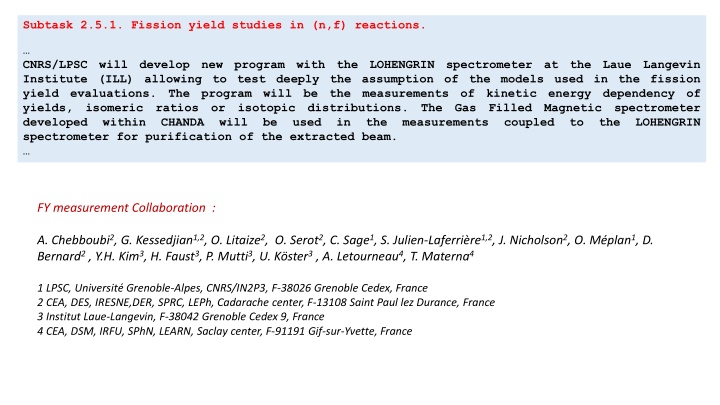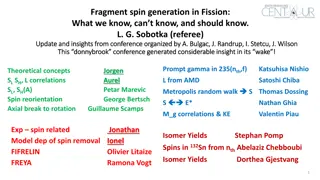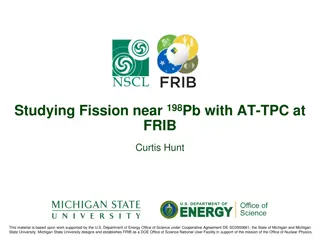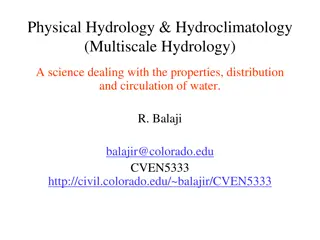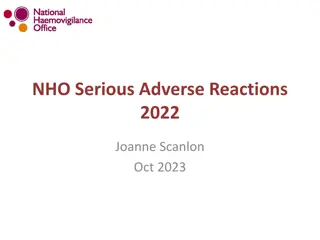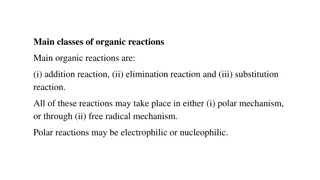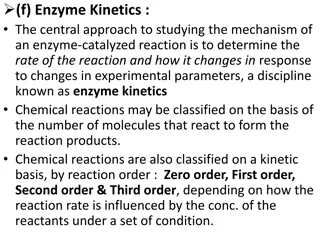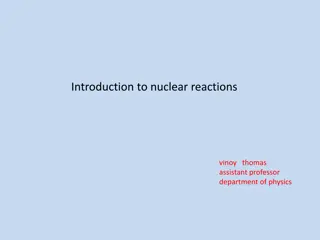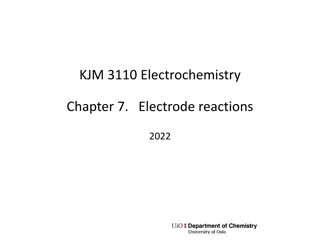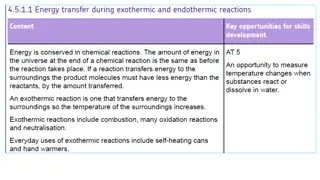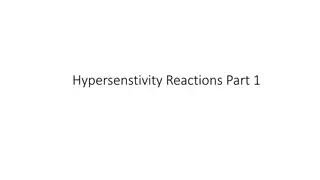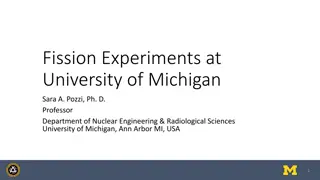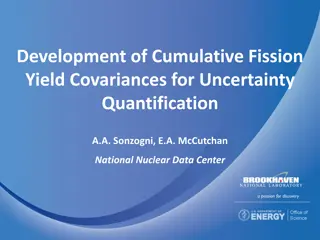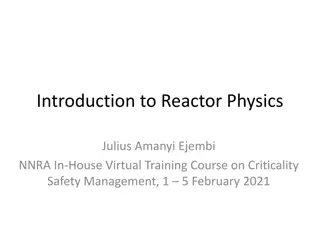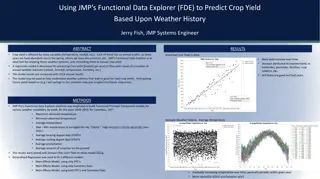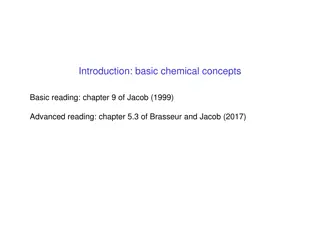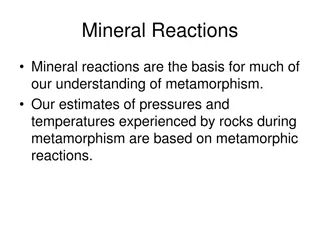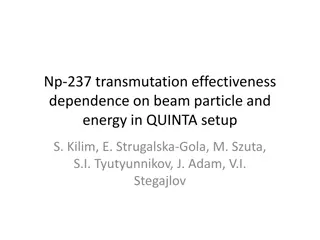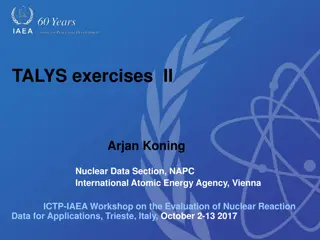Fission Yield Studies in (n,f) Reactions at CNRS/LPSC Institute
Fission yield studies in (n,f) reactions are conducted at the CNRS/LPSC Institute to evaluate and test assumptions in fission yield models. The program focuses on isomeric ratios, isotopic distributions, and measuring kinetic energies using spectrometry techniques with the LOHENGRIN spectrometer.
Download Presentation

Please find below an Image/Link to download the presentation.
The content on the website is provided AS IS for your information and personal use only. It may not be sold, licensed, or shared on other websites without obtaining consent from the author.If you encounter any issues during the download, it is possible that the publisher has removed the file from their server.
You are allowed to download the files provided on this website for personal or commercial use, subject to the condition that they are used lawfully. All files are the property of their respective owners.
The content on the website is provided AS IS for your information and personal use only. It may not be sold, licensed, or shared on other websites without obtaining consent from the author.
E N D
Presentation Transcript
Subtask 2.5.1. Fission yield studies in (n,f) reactions. CNRS/LPSC Institute (ILL) allowing to test deeply the assumption of the models used in the fission yield evaluations. The program will be the yields, isomeric ratios or isotopic distributions. developed within CHANDA will be used in spectrometer for purification of the extracted beam. will develop new program with the LOHENGRIN spectrometer at the Laue Langevin measurements of Gas kinetic Filled coupled energy Magnetic to dependency spectrometer the LOHENGRIN of The the measurements FY measurement Collaboration : A. Chebboubi2, G. Kessedjian1,2, O. Litaize2, O. Serot2, C. Sage1, S. Julien-Laferri re1,2, J. Nicholson2, O. M plan1, D. Bernard2, Y.H. Kim3, H. Faust3, P. Mutti3, U. K ster3, A. Letourneau4, T. Materna4 1 LPSC, Universit Grenoble-Alpes, CNRS/IN2P3, F-38026 Grenoble Cedex, France 2 CEA, DES, IRESNE,DER, SPRC, LEPh, Cadarache center, F-13108 Saint Paul lez Durance, France 3 Institut Laue-Langevin, F-38042 Grenoble Cedex 9, France 4 CEA, DSM, IRFU, SPhN, LEARN, Saclay center, F-91191 Gif-sur-Yvette, France
LOHENGRIN measurements The fission fragment separator Lohengrin @ the high-flux reactor of the Institute Laue Langevin in Grenoble (France) Position 1 : Staight beam ionisation Chamber (IC) for the mass Yield measurement: Y(A) Position 2 : Bent beam two clover Ge (spectrometry gamma) for the Isotopic and Isomeric Yield measurement: Y(A, Z, m) Combination of a magnetic and electric fields allows a selection of the Fission Products (FP) according to their A/q and E/q ratios Target placed close to the core of the reactor: thermal neutron flux of about 5.3x1014n/cm2/s A: mass of the FP E: Kinetic energy of the FP q: ionic charge of the FP
LOHENGRIN measurements S. Julien-Laferri re et al., PHYSICAL REVIEW C 102, 034602 (2020) Isotopic measurements & Isomeric ratio (IR) measurement as a function of the Kinetic Energy J. Nicholson et al., Proc. Theory5 , Barga, Italy, 24-26 Sept. 2019 A. Chebboubi, et al., Physics Letters B 775 (2017) 190 195 132Sn 241Pu 235U A=139 <IR |235U(nth,f)>=0.054 0.007 <IR | 241Pu(nth,f)>=0.072 0.002 Example of isotopic yield measurements for the mass A=139 in the case of241Pu(nth,f) reaction. Similar behaviour of the isomeric ratio for 132Sn with kinetic energy was found for both 235U(nth,f) and 241Pu(nth,f) reactions
LOHENGRIN measurements Measurement of the charge polarization The charge polarization is defined as the difference of the most probable nuclear charge (Zp) and ZUCD, where ZUCDis obtained from the Unchanged Charge Density assumption 241Pu(nth,f) Z = ZP ZUCD The knowledge of Z is very important for the future fission yield evaluations Preliminary results
Task 4.2.1: Evaluation of Fission yields The analysis and evaluation of fission yields is also of prime importance for many applications (e.g. correct estimation of the content of spent nuclear fuel). The CEA/DEN, CNRS/LPSC have a large experience in measuring, analysing and evaluating thermal neutron- induced fission yields. In the framework of a collaboration between the Physical Studies Laboratory (LEPh) of the CEA (France), the Subatomic and Corpuscular Physics lab (LPSC of CNRS) of Grenoble (France) and others, a program of actinide fission yield measurements of interest for the current and innovative nuclear reactors has been initiated for several years. In this task, the proposed work will allow to deeply test some model assumptions used in the fission yield evaluations. The program will be based on the measurements of kinetic energy dependency of yields, isomeric ratios or isotopic distributions. It is defined in three parts: two experimental, and the last one dealing with the improvement of the modelling of the fission products used in the evaluations (e.g. modelling of the fission products from the FIFRELIN Monte Carlo code). FY measurement Collaboration : A. Chebboubi2, G. Kessedjian1,2, O. Litaize2, O. Serot2, C. Sage1, S. Julien-Laferri re1,2, J. Nicholson2, O. M plan1, D. Bernard2, Y.H. Kim3, H. Faust3, P. Mutti3, U. K ster3, A. Letourneau4, T. Materna4 1 LPSC, Universit Grenoble-Alpes, CNRS/IN2P3, F-38026 Grenoble Cedex, France 2 CEA, DES, IRESNE,DER, SPRC, LEPh, Cadarache center, F-13108 Saint Paul lez Durance, France 3 Institut Laue-Langevin, F-38042 Grenoble Cedex 9, France 4 CEA, DSM, IRFU, SPhN, LEARN, Saclay center, F-91191 Gif-sur-Yvette, France
Tests of some model assumptions used in the FIFRELIN code FIFRELIN (developed at CEA-Cadarache) = Monte-Carlo code for O. Litaize, O. Serot Phys. Rev. C 82, 054616 (2010) O. Litaize, O. Serot, L. Berge Eur. Phys. J. A. 51, 177 (2015) Calculating fission observables: spectra and multiplicities of the prompt neutron and gamma particles; energies released; fission yields ) D. Regnier, O. Litaize, O. Serot Comp. Phys. Commun. 201, 19 (2016) Investigating correlations between fission observables Light fragment Heavy fragment FIFRELIN can be a useful code for the future Fission Yield Evaluation Schematic view of the de-excitation of Fission Fragments
LOHENGRIN measurements Local odd-even effect ( Z) measurement as a function of the Kinetic Energy S. Julien-Laferri re et al., PHYSICAL REVIEW C 102, 034602 (2020) The local odd-even effect Z(A) for a given mass is determined as follows: Example of isotopic yield measurements for the mass A=139 in the case of241Pu(nth,f) reaction. The local odd-even effect can be determined for each kinetic energy using FIFRELIN code A=139
Tests of some model assumptions used in the FIFRELIN code The local odd-even effect Z measured as function of fission fragment kinetic energy was compared with the FIFRELIN predictions: According to FIFRELIN, Z has several contributions coming from the prompt neutron emission: P= 0, 1, 2, 3 (in colors on the figure) By adding all these contributions, experimental data can be well reproduced. A=139 241Pu(nth,f) The structure seen on Z can be therefore interpreted as due to the prompt neutron emission.
Tests of some model assumptions used in the FIFRELIN code J. Nicholson et al., Proc. Theory5 , Barga, Italy, 24-26 Sept. 2019 Spin determination from Isomeric Ratio measurements A. Chebboubi, et al., Physics Letters B 775 (2017) 190 195 6.5 132Sn 241Pu(n,f) 235U(n,f) 6.0 132Sn 241Pu(n,f) 235U(n,f) Isomeric Ratio 5.5 Jrms ( ) 5.0 4.5 4.0 3.5 Kinetic Energy (MeV) 80 90 60 70 75 85 55 65 Kinetic Energy (MeV) From the Isomeric Ratio measurements (LOHENGRIN), the spin of the Fission Product can be deduced (FIFRELIN): a very similar average spin value of the 132Sn was found for both fission reactions
LOHENGRIN measurements Current developments on LOHENGRIN Our aim: Investigate symmetric mass region which may give some insight on the validity of Brosa modes (competition between Standard I and Super Long modes) Problem: Presence of contaminants (undesired masses from LOHENGRIN) in the symmetry and far asymmetric mass regions (low fission yields) Solution: identify clearly the contaminants by adding a Time of Flight system on LOHENGRIN (PhD started in october 2020) and remove their contributions. Start new measurements in the symmetric mass region in 2021 (235U(nth,f))
LOHENGRIN measurements used for testing models in the FIFRELIN Monte Carlo code Some highlights on Mass, Isotopic and Isomeric yields calculations performed with FIFRELIN 239Pu(nth,f) 233U(nth,f) 239Pu(nth,f)
LOHENGRIN measurements used for testing models in the FIFRELIN Monte Carlo code Current developments on FIFRELIN : Development planned in FIFRELIN Calculation of cumulative FY by introducing the Q matrix Calculation of the average delayed neutron multiplicity (useful for validation of FY evaluations)
